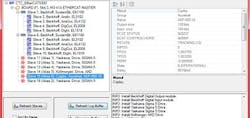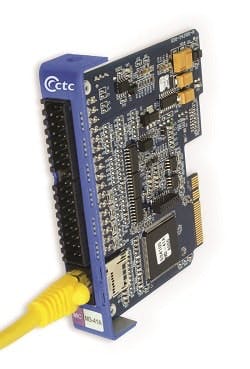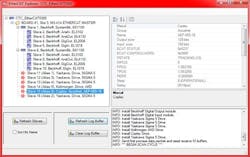The advent of networked motion and I/O has simplified control integration, allowing termination and use at the point of need, easier troubleshooting, highly deterministic performance and improved I/O response. With common tools such as Ethernet wire and RJ45 connectors, the job is made easier.
SEE ALSO: Connectivity for Custom I/O
EtherCAT is what Control Technology Corp. (CTC) will tell you takes those improvements a giant step forward. The M3-41A EtherCAT Master is company's most recent offering for its model 5300 programmable automation controller (PAC).
"The beauty of EtherCAT technology is that it addresses one of the major limitations of other Ethernet solutions," believes CTC's CEO, Tom Schermerhorn. "Processing 'on the fly' means that the EtherCAT slave device reads the data addressed to it and inserts its response while the frame passes through the node, with a delay of only nanoseconds."
EtherCAT offers capabilities not available with other motion control paradigms. CTC says it has made the protocol easier to work with by "pre-configuring" devices for use with its EtherCAT Master — and ease of use translates to improvements in time to market for machine builders and systems integrators.
Unlike other EtherCAT Masters, CTC says M3-41A isolates the user from the complexity of the EtherCAT environment by automatically scanning the network and configuring recognized devices. High-level motion control commands are accomplished using QuickBuilder, CTC's standard programming environment.
The CTC EtherCAT Master supports servo and stepper drives, and I/O devices. The module is pre-configured for use with the following motor drives and I/O:
- Yaskawa Sigma 5
- Copley Accelnet
- Kollmorgen AKD
- Sanyo Denki SANMotion RS2E
- Control Techniques
- SMC
- I/O blocks: Beckhoff, Wago
The company says more products are being tested and pre-configured as it recognizes the need or receives requests from customers. "Users won't need to wrestle with a complex configurator, poke drive objects, or figure out how interfaces work," Schermerhorn says. "Each supported device has been verified with the M3-41A and all set-ups and initialization has been completed ahead of time. This greatly simplifies the EtherCAT installation, allowing users to concentrate on their control needs at a much higher level and the integration of their system – skipping the need for a complicated configurator. Multiple networks are supported to CTC's main and may be intermixed with other networks such as EtherNet/IP, DeviceNet, and BACnet using a separate Ethernet port."
- Cyclic sync position, interpolated position, profile velocity, and position modes supported
- Distributed clocks by default, syncs master to slaves and triggers motions simultaneously
- Absolute encoding capability (automatically pick up where left off or automatic homing)
- 16 axis support at 1mS, including I/O
- Segmented, geared, position, velocity and cammed moves
- Any axis can track and gear off any other axis
- Multi-master and virtual master support
- Currently supports Beckhoff and Wago digital and analog I/O blocks
- Native communication using Modbus, DeviceNet, Ethernet/IP, and BACnet via separate ports
- Multiple EtherCAT Master networks supported
- Built-in diagnostics
CTC says high-level motion control commands are standard in its QuickBuilder programming environment, which gives access to a wide variety of tools for setting up and programming the system. "Its object-oriented approach simplifies application creation and maintenance," Schermerhorn adds. "Performance is improved by off-loading demanding motion control tasks to the specialized motion control processors on the EtherCAT Master module."
QuickBuilder uses Motion Sequence Block (MSB), which are standalone blocks of code that become part of the motion program. Users can create MSBs and use them over again in the same motion application or in new applications, saving time and effort.
About the Author
Joe Feeley
Joe Feeley

Leaders relevant to this article:



